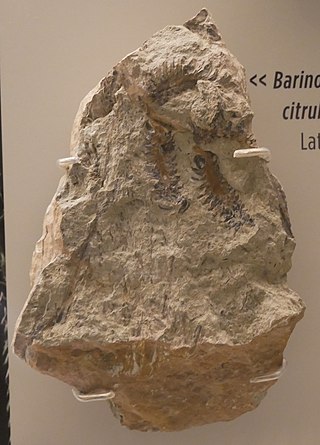Crenaticaulis was an early genus of slender, dichotomously branching, leafless land plants, known from the Devonian period and first described in 1969. They were probably allied to the zosterophylls, and are assigned to subdivision Zosterophyllophytina, or class Zosterophyllopsida. They bore branches and scalariform tracheids.

Polysporangiophytes, also called polysporangiates or formally Polysporangiophyta, are plants in which the spore-bearing generation (sporophyte) has branching stems (axes) that bear sporangia. The name literally means 'many sporangia plant'. The clade includes all land plants (embryophytes) except for the bryophytes whose sporophytes are normally unbranched, even if a few exceptional cases occur. While the definition is independent of the presence of vascular tissue, all living polysporangiophytes also have vascular tissue, i.e., are vascular plants or tracheophytes. Extinct polysporangiophytes are known that have no vascular tissue and so are not tracheophytes.

The Horneophytopsida, informally called horneophytes, are a class of extinct plants which consisted of branched stems without leaves, true roots or vascular tissue, found from the Late Silurian to the Early Devonian. They are the simplest known polysporangiophytes, i.e. plants with sporophytes bearing many spore-forming organs (sporangia) on branched stems. They were formerly classified among the rhyniophytes, but it was later found that some of the original members of the group had simple vascular tissue and others did not. The group has also been treated as the division Horneophyta.
Uskiella is a genus of small fossil plants of Early Devonian age. The diagnostic characters are naked axes branching isotomously, terminating in ellipsoidal, vertically elongate flat sporangia which split longitudinally into two valves. Spores of U. reticulata have a reticulate appearance. Coalified specimens have been reported from Wales, with a possible occurrence in Australia.

Yunia is a genus of extinct vascular plants from the Early Devonian. It was first described from the Posongchong Formation of Yunnan, China. The leafless plant consisted of spiny stems, some 2 to 5 cm wide, which branched dichotomously at wide angles in a cruciate arrangement. Each stem contained vascular tissue with one or two strands of protoxylem. The spore-forming organs (sporangia) were elongated and borne on short stalks. The spores had a relatively smooth sculptural pattern and were trilete.
Sartilmania is a genus of extinct vascular plants of the Early Devonian. Fossils were found on the Sart Tilman campus of the University of Liège, Belgium.
Hicklingia is a genus of extinct plants of the Middle Devonian. Compressed specimens were first described in 1923 from the Old Red Sandstone of Scotland. Initially the genus was placed in the "rhyniophytes", but this group is defined as having terminal sporangia, and later work showed that the sporangia of Hicklingia were lateral rather than strictly terminal, so that it is now regarded as having affinities with the zosterophylls.
Huia is a genus of extinct vascular plants of the Early Devonian. The genus was first described in 1985 based on fossil specimens from the Posongchong Formation, Wenshan district, Yunnan, China.
Gumuia is a genus of extinct vascular plants of the Early Devonian. The genus was first described in 1989 based on fossil specimens from the Posongchong Formation, Wenshan district, Yunnan, China.

Adoketophyton is a genus of extinct vascular plants of the Early Devonian. The plant was first described in 1977 based on fossil specimens from the Posongchong Formation, Wenshan district, Yunnan, China. These were originally named Zosterophyllum subverticillatum; later the species was transferred to a new genus as Adoketophyton subverticillatum. One cladistic analysis suggested that it is a lycophyte, related to the zosterophylls. Other researchers regard its placement within the vascular plants as uncertain.
Thrinkophyton was a genus of Early Devonian land plant with branching axes. Known fossils are of Lochkovian to Pragian age.
Gosslingia was a genus of Early Devonian land plant with branching axes. Fossils have been from the Lochkovian to the Pragian, 419 to 408 million years ago.
Serrulacaulis was a genus of early land plant with branching axes. Known fossils are of Late Devonian age.
Tarella was a genus of Early Devonian land plant with branching axes. Fossils came from Pragian age rocks.
Oricilla was a genus of Early Devonian land plant with branching axes. Fossils have been found from the Pragian to the Emsian.
Konioria was a genus of early land plant with branching axes. Known fossils are of Early Devonian age.

Barinophyton was a genus of early land plant with branching axes. It is placed in a group of early vascular plants (tracheophytes), the barinophytes, a group that has been given various ranks and scientific names. Known fossils are of Devonian to Carboniferous age.
Protobarinophyton was a genus of Silu-Devonian land plant with branching axes. It is placed in a group of early vascular plants (tracheophytes), the barinophytes, a group that has been given various ranks and scientific names.
Anisophyton was a genus of Early Devonian land plant with branching axes. Known fossils are of Emsian age.
The barinophytes are a group of extinct vascular plants (tracheophytes). Their relationship with other vascular plants is unclear. They have been treated as the separate class Barinophytopsida, the order Barinophytales of uncertain class and as a family or clade Barinophytaceae within the zosterophylls. They have also been considered to be possible lycopodiopsids.




